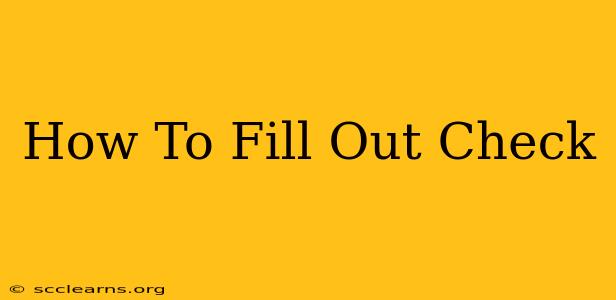Writing a check might seem old-fashioned in our digital age, but knowing how to do it correctly is still a valuable skill. Whether you're paying bills, rent, or a friend, understanding the process ensures your payment goes through smoothly and avoids potential issues. This comprehensive guide will walk you through each step, ensuring you can confidently fill out a check every time.
Understanding Check Components
Before we dive into the process, let's familiarize ourselves with the key parts of a check:
- Check Number: A unique number assigned to each check, used for tracking purposes.
- Date: The date you are writing the check.
- Pay to the order of: This line is where you write the name of the person or entity receiving the payment. Be precise and spell the name correctly.
- Amount in Numbers: Write the numerical amount of the check. Ensure this matches the written amount.
- Amount in Words: Write the amount of the check in words. This is crucial for security. Start with the dollar amount and then write “and” followed by the cents. For example, $125.50 would be written as "One Hundred Twenty-Five and 50/100 Dollars."
- Memo: This section is for optional notes or descriptions of the payment.
- Your Signature: Sign the check in the designated area. This verifies the payment.
- Your Account Number: Located at the bottom of the check.
- Your Bank's Routing Number: Used to identify your bank.
Step-by-Step Guide to Filling Out a Check
-
Fill in the Date: Write the date in the upper-right corner of the check. Use the month, day, and year format (e.g., 01/27/2024).
-
Write the Payee's Name: In the "Pay to the order of" line, write the full legal name of the person or business receiving the payment. Avoid abbreviations or nicknames unless you're absolutely certain they'll be accepted.
-
Enter the Amount Numerically: Write the amount of the check in numbers directly to the right of the dollar sign ($) in the space provided.
-
Write the Amount in Words: Write the same amount in words on the next line, starting at the far left. Spell out the number carefully. Remember to include "Dollars" at the end, and write the cents as a fraction over 100 (e.g., 50/100). This step is vital to prevent fraud and discrepancies.
-
Complete the Memo (Optional): Use the "Memo" line to add a brief description of the payment (e.g., "Rent," "January Invoice"). This is helpful for both you and the recipient.
-
Sign the Check: Sign your name exactly as it appears on your bank account.
-
Double-Check Everything: Before detaching the check, carefully review every field to ensure accuracy. A small mistake can lead to delays or returned checks.
Avoiding Common Mistakes
- Mismatched Amounts: The most common mistake is a discrepancy between the numerical and written amounts. Always double-check these figures for perfect alignment.
- Spelling Errors: Incorrectly spelling the payee's name can lead to rejection. Take your time and write clearly.
- Forgetting Your Signature: An unsigned check is invalid. Never forget to sign!
- Using Correction Fluid: Never use correction fluid or white-out on a check. This raises suspicion of fraud. If you make a mistake, start over with a new check.
Beyond the Basics: Mobile Check Deposit
Many banks now offer mobile check deposit features through their mobile apps. This allows you to deposit checks directly into your account using your smartphone, eliminating the need to physically visit the bank. Check with your bank for availability and instructions on how to use this convenient service.
By following these steps, you'll be well-equipped to confidently write checks, ensuring smooth and accurate transactions every time. Remember, accuracy and precision are paramount when dealing with financial documents.

